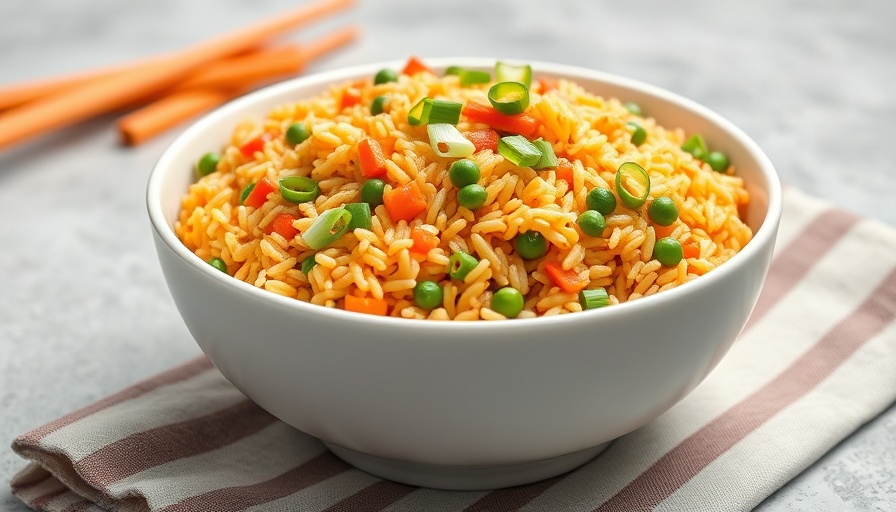
Rediscovering Comfort: The Allure of Homemade Fried Rice
Ordering fried rice from your favorite restaurant is a dining ritual many cherish. The steamy aroma and savory flavors are hard to resist. However, mastering the art of fried rice at home not only satisfies cravings but also empowers you in the kitchen. This easy fried rice recipe ultimately allows for creativity and waste reduction by utilizing leftover veggies, transforming what might be ordinary ingredients into an extraordinary dish.
In 'Easy FRIED RICE Recipe at Home!', the discussion dives into cooking techniques and ingredient choices that sparked deeper analysis on our end.
Essential Ingredients: Making the Most of What You Have
At the heart of any great fried rice is a blend of fresh and cooked ingredients, and what's fascinating is its adaptability. Whether you choose a bright orange carrot, frozen peas, or a few green onions, the list is virtually limitless. Dicing one large carrot, or two smaller ones, serves as a great start. You may find carrots readily available in your fridge since they are a staple ingredient. Meanwhile, adding a splash of freshness with green onions enhances the dish without an extensive shopping list. Furthermore, incorporating minced ginger not only packs flavor but also brings numerous health benefits to the table, fortifying your immune system while adding depth to your meal.
Day-Old Rice: The Key Ingredient to Perfect Fried Rice
One of the secrets to achieving the ideal texture in your fried rice lies in using day-old rice. The reason? Freshly cooked rice tends to stick together, leading to a clumpy result that is far from desirable. Day-old rice, on the other hand, is less hydrated and more suitable for stir-frying, resulting in that sought-after fluffy dish that is filled with flavor. If you're meal prepping, it's best practice to spread out cooked rice on a sheet pan to allow it to cool quickly and prevent settling. This technique not only preserves food safety but contributes to the quality of your fried rice when you finally use it.
From Pan to Plate: Cooking Techniques for Best Results
As you stand at the stove preparing this simple yet sophisticated dish, remember that timing and technique are crucial. Start by heating high-heat oil, which allows for quick cooking without burning. Many traditional recipes suggest scrambling eggs separately before introducing vegetables, but the technique of scrambling them alongside them simplifies cooking and reduces the number of dishes to clean later. This method has roots in authentic Thai cooking and is not only practical but emphasizes a harmonious blend of flavors throughout the cooking process.
Sauces that Sing: Elevating Your Fried Rice
The flavor profile of your homemade fried rice culminates in a simple yet impactful blend of tamari soy sauce and toasted sesame oil. This mixture does not simply flavor the rice; it transforms it, creating that beautiful golden brown color associated with takeout fried rice. Be cautious with white pepper—used judiciously, it adds just a hint of spice; too much can overpower your creation. If you're not adhering to a gluten-free diet, incorporating oyster sauce can elevate umami tones even further.
Serving Suggestions: From Family Style to Fine Dining
Once your fried rice is beautifully prepared, consider how best to serve it. For a family-style meal, place it in a large bowl, inviting everyone to dig in. Alternatively, to impress dinner guests or for a special occasion, consider using small bowls as molds to create a stunning presentation on individual plates. This stylish serving method demonstrates a level of care and creativity while enjoying your meal. Pair your fried rice with other delectable dishes, such as Kung Pao chicken or egg drop soup, for a feast that tantalizes the senses.
Fried Rice in Popular Culture: More than Just Food
Fried rice acts as more than just comfort food—it is a symbol of culinary versatility across cultures. From its humble beginnings in Chinese kitchens to its global adaptations, fried rice reflects the importance of innovation in cooking. Restaurants utilize specific adaptations to cater to local tastes, showcasing the endless possibilities when it comes to preparing this beloved dish. Moreover, its ability to utilize leftovers embodies a sustainable approach to cooking, aligning with present-day efforts to minimize food waste.
Conclusion: Embrace the Simplicity of Homemade Fried Rice
Crafting your own fried rice is not just about following a recipe; it's a delightful culinary experience that encourages creativity and resourcefulness. By mastering this simple yet satisfying dish, you celebrate both flavors and sustainability in the kitchen. Whether it's a casual weeknight meal or an elegantly presented dish to impress guests, fried rice holds a special place in hearts and homes worldwide.
Ready to transform your kitchen skills with this easy fried rice recipe? Explore your own variations, use leftovers creatively, and enjoy the process of cooking at home. Your taste buds—and maybe even your friends—will thank you!
 Add Row
Add Row  Add
Add 




Write A Comment